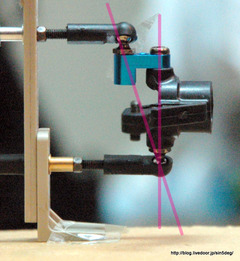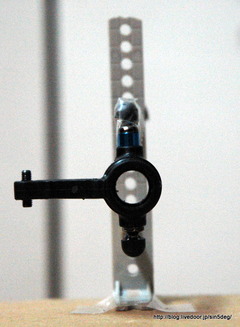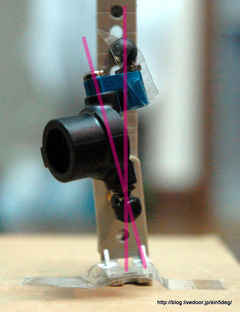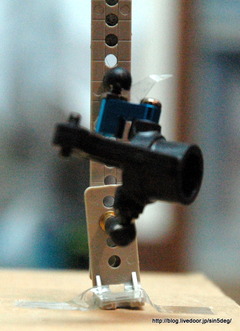Now that we covered the BASIC alignment in the front, let's move on to the ADVANCED settings. Please check my BASIC alignment post if you have not covered that yet.
https://ameblo.jp/marcus38060/entry-12351833320.html
WHAT IS KPI (KING PIN INCLINATION)?
I'm sure you've heard people talk about KPI or seen it in the product name of a front knuckle. Caster is the steering pivot point or the king pin angle in the front to back direction of the chassis. KPI is the steering pivot point or the king pin angle in the left to right direction of the chassis, leaning in to the chassis at the top, but not to be confused with camber.
KPI will change the progression of the camber in combination with the caster throughout the steering stroke. This is a compound element of camber, caster and KPI, but in short, KPI prevents the front tire camber to become excessive in negative or positive.
Leading tire = KPI will add the amount of positive camber gain, so negative camber at neutral will progress to zero, then to positive camber
Trailing tire = KPI will cancel out the amount of negative camber gain to prevent reaching extreme negative camber
Below is a great link (in Japanese) using a test bench to explain KPI and how KPI affects camber progression.
http://blog.livedoor.jp/sin5deg/archives/51624000.html
*Courtesy of sin5deg
HOW DO YOU ADJUST KPI?
Adjusting KPI will require a specific front knuckle. Most brands have their version of front knuckles with KPI adjustment. Some provide very fine adjustability with spacers, some allows hole position of the top or bottom king pin or ball connection to be mounted.
Changing the KPI will require changing the length of the upper and/or lower arm, steering linkage, ackerman etc... so this is why KPI is a more advanced front alignment setup, and most likely it will be a trial and error until you find what you like.
WHY IS KPI IMPORTANT?
So why do you need KPI? KPI is to avoid the excessive amount of camber, both negative and positive when the tire as the steering progresses from neutral to a specific angle towards full lock position. As noted in the BASIC alignnment, it’s how you use the tire contact patch as RWD RC Drift tires are hard plastic. Using too much of the edge can pull the chassis in one direction having too much grip on either the leading or the trailing tire.
By using KPI, you can set the camber, say around negative 7 at neutral, and the negative camber on the trailing tire can actually be kept 'consistent' until reaching full lock. The leading tire can progress from negative camber to zero camber and allow full contact patch at the optimal angle, then transition to positive camber.
Final setting and preference is up to you and what surface you run. My default camber setting at neutral is negative 7deg, caster at positive 5 deg and KPI at 5 deg. This seems to give me a very neutral steering characteristic.
WHAT IS TRAIL?
This is another tricky one that not many people utilize. Trail is the offset of the tire axle or tire rotation center relative to the steering pivot point or king pin. Trail will add stability to maintain the direction the chassis is going, but too much trail will make the steering sluggish.
Trail has a similar effect as adding more caster, but adding extreme caster makes the tires lean too much at full lock, so adding trail and reducing the caster as a combination is another way to dial in your alignment for stability. Some front knuckles have additional holes in front or back of the hole on centerline of the front axle. Moving it forward to add trail will make the front tires stable. Moving it backward will make the steering quick, but will reduce stability. The picture shown below shows two rows of mounting pattern, forward/backward is adjusting trail, and inward/outward adjusts KPI.
WHAT IS SCRUB?
Scrub is the distance or radius of the steering pivot point or king pin to the center of the tire. What scrub does is it dictates how much the front tires move relative to the steering radius. More scrub you have, the more the tire will have to travel and not only will make the tire look funky at full lock, but too much scrub will drag the front tire as you steer and makes the chassis unstable.
Scrub is adjusted by the combination of knuckle, thickness of the hex hub and the wheel offset. Yokomo YD-2 comes with 8mm hex and wheel offset needs to be around 6-8mm to get a good full lock. This is 14 to 16mm scrub radius total, not taking into account the offset in the front knuckle for simplifying the discussion. YD-2 stock knuckles which believe has a small scrub radius in itself, but some knuckles have larger scrub radius, so you will have to determine the hex and wheel offset and try to find the minimum offset that gives you maximum lock angle. Less scrub is better, but I would not try to go too crazy in reducing the scrub as you will lose steering angle by reducing the scrub.
Additional element to keep in mind is that scrub will also change by adjusting camber and KPI. As the front tire leans more, adding negative camber, the scrub will increase, but very slightly. Addining KPI will have more impact in reducing scrub. Scrub can also be adjusted with the holes on the knuckle if the knuckle has scrub option (hole option also shown on the picture above).
SO WHAT??
Okay, so I covered a LOT of things between the BASIC and the ADVANCED alignment for the front tires. I would recommend spending time in dialing it in to what you like, and stick with it, even when the surface changes.
However, this is still not the end of it. There is a another big 'theme' on ackerman and also bump steer to complete the full alignment of the front tires. I would like to cover steering lever ratio after that which this is not a topic many people talk about, but very important for the front steering and gyro setup.
Happy drifting!
February 17, 2018 / Charlotte NC
My FB:
https://www.facebook.com/masanori.morizuka
https://www.facebook.com/RWDRCDriftTuning/













